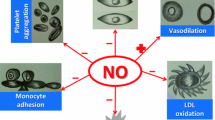Summary
Endothelially derived nitric oxide (NO) regulates vasodilatation via relaxation of the smooth muscle cells and inhibits platelet aggregation in addition to a number of other biological processes. Animal experiments have provided evidence for increased NO production in the normal pregnancy. This contributes to the decrease in peripheral vascular resistance and to the increased glomerular filtration rate. Inhibition of NO synthesis is associated with a preeclampsia-like syndrome in various animal species. In vivo and in vitro data in the human pregnancy have indicated that NO deficiency contributes to the vasoconstriction seen in preeclampsia. However, due to the short half-life time of NO, pharmacological application is only possible by NO-donating drugs such as glycerol trinitrate (GTN, “nitroglycerine”), isosorbide dinitrate (ISDN), isosorbide mononitrate (ISMN) or S-nitrosoglutathion (GSNO). There is limited experience with the use of NO donors in human pregnancy; yet no teratogenic or embryotoxic effects are reported. According to current knowledge, transdermal application of GTN in pregnancy is safe with only minor effects on maternal blood pressure and without compromising the uteroplacental perfusion in patients with preeclampsia. Up to now only one prospective randomized trial has been conducted on the prophylaxis of preeclampsia by NO donors in women at high risk for development of the disease. However, the sample size of this study was too small to allow final conclusions. There are no randomized trials on the therapy of preeclampsia by NO donors reported in the literature. Therefore, it is that the use of NO donors be evaluated in the prophylaxis and therapy of preeclampsia only recommended in the context of clinical trials.
Zusammenfassung
Die wichtigsten Funktionen von endothelial gebildetem Stickstoffmonoxid (NO) bestehen in der Vasodilatation durch die Relaxation der glatten Gefäßmuskulatur und in der Inhibition der Plättchenaggregation im Gefäßlumen. Tierexperimentelle Untersuchungen zeigen, daß eine Mehrproduktion von NO in der normalen Schwangerschaft zu der Abnahme des Gesamtgefäßwiderstandes und zum Anstieg der glomerulären Filtrationsrate beiträgt. Eine Hemmung der NO-Synthese führt zu einem präeklampsieähnlichen Krankheitsbild. Neuere In-vivo- und In-vitro-Untersuchungen weisen darauf hin, daß ein Mangel an NO zur Vasokonstriktion bei der Präeklampsie beiträgt. Aufgrund dieser Befunde wäre NO ein ideales Medikament zur Therapie der Präeklampsie und könnte evtl. auch in der Prophylaxe der Erkrankung eingesetzt werden.
Nach den vorliegenden Untersuchungen ist die transdermale Verabreichung von NO-Donatoren eine sichere Methode, die nur eine geringe Auswirkung auf den Blutdruck bei Patientinnen mit Präeklampsie hat und die fetale Versorgung verbessert. Damit könnten präeklamptische Schwangerschaften in einem frühen Schwangerschaftsalter möglicherweise prolongiert werden. Die Prophylaxe der Präeklampsie ist in lediglich einer gut angelegten Studie untersucht, die aber aufgrund der geringen Zahl untersuchter Patientinnen keine definitive Antwort zuläßt. Deshalb ist der Einsatz von NO-Donatoren zur Prophylaxe oder Therapie der Präeklampsie derzeit nur im Rahmen von Studien zu empfehlen.
Similar content being viewed by others
Author information
Authors and Affiliations
Rights and permissions
About this article
Cite this article
Beinder, E., Mohaupt, M. NO donors for the regulation and treatment of preeclampsia diseases. Gynäkologe 32, 768–775 (1999). https://doi.org/10.1007/PL00003182
Published:
Issue Date:
DOI: https://doi.org/10.1007/PL00003182




